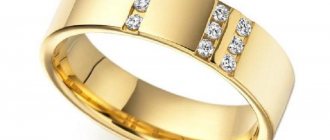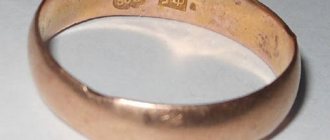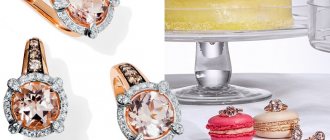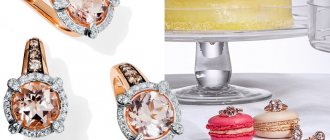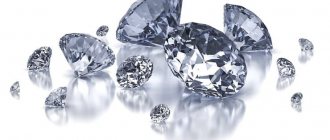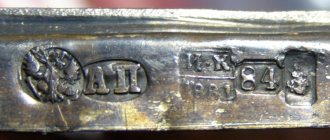Post updated: May 25, 2020
Gold is beautiful not only in its “standard” state in the form of 999 fine bars, but also in its diversity. It is a metal that is considered noble and precious. In the periodic table it is designated as Aurum - from Latin it is translated as “golden”. This element has exceptional properties - softness, ductility, malleability, high electrical and thermal conductivity. It has increased density, does not react with the environment and combines well with other metals in alloys. The jewelry industry continues to create more and more new types of gold. The list of advantages allowed this particular metal, quite rare on a planetary scale, to become the most desirable in all countries of the world.
By extraction method
Gold extracted from the depths of the earth is divided into two main groups: endogenous (it is also called indigenous, primary, ore) and exogenous (placer). They differ in the method of formation and depth of occurrence.
Rudnoe
Indigenous gold is the result of magmatic processes that occurred in the earth's crust thousands of years ago. During volcanic eruptions, streams of magma, which are a melt of various compounds, burst to the surface. The elements forming them gradually cooled, but this process was uneven.
The last to remain were the fusible elements located in the center of the magma flow. They did not freeze, but continued to actively circulate until they cracked outward, forming veins. Further decomposition of elements occurred in them until only hot solutions of gold-containing salts remained. Gradually they also solidified and then crumbled, leaving crystals of pure gold.
Placer
The number of exogenous mines is much larger. They are found in all gold-bearing provinces of the world. By its origin, placer gold is endogenous deposits destroyed under the influence of the external environment.
When the bedrock veins are destroyed, the gold crystals are freed from most of the accumulations of foreign ore. Under the influence of rain and melted snow, the placers gradually move down the slope. If a mountain stream comes across the path of the sliding precious metal, the speed of movement increases, and the gold itself ends up in the valleys.
In water, the precious metal is finally cleared of impurities and settles at the bottom. Ores of other metals have less weight and are destroyed or weathered under the influence of river flow. Gold in water moves at a minimum speed, forming a placer.
Supply and demand in the market
Numerous types of high-quality gold allow everyone to choose this metal, focusing on their needs. Bankers and investors want pure gold, which they can purchase from a government bank or an international exchange. Those who want to make an investment in the family future, but are afraid to depend on the exchange rate, are suitable for small bars and coins, which are issued in limited editions during the holidays, because they are the ones that are most likely to increase in price. For companies involved in the production of equipment or medical devices, the cost of gold is important. It is beneficial for them to support new young fields, for example, in Brazil or India.
The jewelry industry is a separate world. Here fashion houses are fighting for the originality of the alloy, because this is the key to unique product design. The buyer must clearly understand why he needs jewelry. Many residents of China, Japan, and India buy gold jewelry for the same purpose for which Europeans buy bullion. For them, this is an investment, not an item for everyday wear. Residents of the USA, Europe and the CIS perceive gold as jewelry in the original sense of the word, so the appearance of the product, its strength, the fashion for the alloy, interesting design, contrast, brightness, and individuality of the model are important to them.
Despite the limited amount of gold in our world, the market can offer a huge number of solutions for each category of buyer. Despite the rise in prices, demand has not fallen, but on the contrary, it has warmed up, as people trust paper money less and less. The system of gold miners, intermediaries, brokers, jewelers, bankers, sellers, resellers, works like clockwork, supplying gold bars and other products to all corners of our world.
By cleanliness
Until the end of the 19th – beginning of the 20th centuries. all major countries had their own ideas about the hallmark of precious metals. In Russia, until 1927, a spool system was used. It was based on a peg to the Russian pound (96 spools). According to it, the sample was determined by the weight of gold in 96 units of the alloy. If there were no foreign metals in the composition, it was considered pure.
Germany used the lot system of samples to determine the purity of gold until 1888. As in Russia, prospectors depended on a currency - the mark, which was in use among the Celtic, Germanic and Scandinavian populations. 1 stamp contained 16 lots.
Nowadays, checking the percentage of precious metal in a product is unified. Based on it, there are officially 2 sample systems: metric, popular in Russia and the CIS countries, and carat, used in the USA and Europe.
The dependence of different sample systems can be tracked in the table below.
| Pure gold content | Metric gold standard | British carats | Spool system | Lot system |
| 99% | 999 | 24 K | 96 | 16 |
| 95,80% | 958 | 23 K | 92 | – |
| 87,50% | 875 | 21 K | 84 | 14 |
| 83,33% | 833 | 20 K | 81 | – |
| 79,17% | 792 | 19 K | 76 | – |
| 75,00% | 750 | 18 K | 72 | 12 |
| 62,50% | 625 | 15 K | 60 | 10 |
| 58,50% | 585 | 14 K | 56 | – |
| 50,00% | 500 | 12 K | 48 | 8 |
| 41,67% | 417 | 10 K | 40 | – |
| 37,50% | 375 | 9 K | 36 | 6 |
| 33,33% | 333 | 8 K | 32 | – |
Ligature and main impurities in gold alloys
The added additives are called alloys, and their amount changes the final properties of the alloy. The natural color of gold is yellow, but thanks to the ligature it is possible to achieve a wide variety of shades, from red to resin.
In Russia, for a long time it was customary to add copper to the precious metal, which is why our gold had a characteristic red color. Europe has always given preference to rich yellow color.
The ligature may consist of the following metals:
- Zinc. In a certain amount it can help achieve an emerald hue, increases the fluidity of the material, and reduces the melting point.
- Platinum. Increases melting point, helps achieve a shiny waxy color.
- Nickel. Increases the alloy's resistance to mechanical damage and corrosion, and brightens it.
- Silver. Makes the precious metal lighter, increases casting properties and final hardness.
- Palladium. Increases the melting point, improves ductility, and makes the alloy lighter.
- Copper. The best additive for hardness, gives a reddish tint.
- Cadmium. Increases casting properties and gives a greenish color.
Interesting fact: to obtain a blue color of the metal, gallium is added to the composition; for a purple tint, aluminum is required. The markings do not affect the color. Precious metals of the same purity come in different shades.
Ligatures of gold alloys
By purpose
Gold can come in the form of bars and jewelry, and can be used even in places you least expect to see it.
Technical
The strength and chemical resistance of gold allows it to be used as a material for electrical contacts, printed circuit boards, connectors and other parts. It replaces the platinum group metals, which have better characteristics but are less expensive.
Gold is also used for soldering metals. And softer alloys are used in ultra-high vacuum technology.
Modern windows, car and stained glass are coated with a thin layer of gold. The presence of such a film reduces heat loss in winter and saves from overheating in summer.
Medical
In the field of medicine, gold alloys are used mainly in two areas: pharmacology and dentistry. In the first case, aurum compounds are added to medicines against arthritis, tuberculosis, malignant tumors, etc. In the second, dentures and crowns are made based on gold and other metals (zinc, copper, silver, platinum, copper).
Chervonnoe
In Rus' it was customary to call gold with a minimum amount of ligature (no more than 10%) red gold. It was used to make coins - chervonets. Pure metal was also widely used for gilding the domes of Orthodox churches. Today, red gold is part of alloys, and in its pure form is found only in the form of bank bars and coins.
Investment
Part of the pure metal obtained after extraction and processing is used as the gold reserve of the country in which it is mined. This is a kind of guarantee that the state’s economy will remain afloat in the event of sharp fluctuations in exchange rates.
The population is guided by a similar principle. Those who prefer to keep their savings in a more reliable equivalent purchase gold coins and bars from banks. Then you can rent a safe deposit box for a certain period or leave the precious metal in your own private collection.
Jewelry
The plasticity and beauty of gold alloys has been appreciated by jewelers since ancient times. Pure metal is practically not used due to its fragility and low wear resistance. It is needed only for creating alloys or gilding products from cheaper materials.
Other classifications
Gold can be divided into banking and jewelry. If in banking the main thing is the purity of the metal and compliance with standards, then in jewelry the artistic element is very important. Obtaining a new shade while maintaining the strength and inertness of the metal in relation to the environment is considered an achievement.
Gold is mined in various parts of the Earth. For many years, the leaders in production have been five countries: Peru, USA, Australia, Russia, and China. South Africa is close to this list. Developments in Africa, Asia and Latin America have been increasing recently, because there is cheap labor, loyal laws and many new deposits. In some places its content in the ore is high and mining easily pays off, in others you have to collect the smallest grains and constantly look for new veins.
Colored
Since pure gold is practically not used in the manufacture of jewelry, it is used in combination with other metals. They not only improve its technical characteristics, but also affect the color scheme of the product.
Yellow
The yellow alloy in jewelry is considered one of the traditional ones. In addition to gold, the composition includes silver and copper, and their proportions vary in color from reddish to lemon. Since there are no strict limits on the amount of alloy for yellow gold, its fineness can vary from the lowest (333) to the highest (958) for the alloy.
Red
If in a mixture of aurum, silver and copper a large proportion falls on the latter element, the product becomes red. Its shades were typical for jewelry produced in the USSR, but it is practically not found in modern Russia. Copper color looks good in combination with other metals (rings made of red and white gold are popular), as well as with precious stones.
White
White gold has now overtaken yellow gold in popularity. It is made with the addition of platinum, silver and palladium. The cost of such a product is an order of magnitude higher than the classic yellow alloy.
Among the advantages of “white” jewelry are high durability and attractive color.
In jewelry, 585 and 750 alloys are used. To reduce the cost of jewelry, white gold is often used in combination with more affordable metals.
Green
Green gold is rare, although its recipe is one of the oldest. The first mentions of it date back to the 1st–2nd millennium BC. In Russia, green alloys are manufactured in two variations:
- 58.5% gold and 41% silver – 585 standard;
- 75.0% gold and 25% silver – 750 standard.
The reason for the rarity of green jewelry is their fragility: the metal breaks down under mechanical stress.
Blue and blue
The blue tint of jewelry occurs when indium is added to the composition. Today, such alloys are considered a myth, since all data about them is only theoretical.
The only person who managed to achieve results, Antoniassi, kept the production technology a secret from his contemporaries and descendants. Blue jewelry that can be found on the shelves of jewelry stores today are alloys coated with varnish or rhodium-plated.
The blue tint is quite real and is realized in unusual and eye-catching jewelry. It is obtained by adding chromium and iron to the alloy. However, as with green gold, the resulting alloy becomes too brittle and brittle to be used in everyday jewelry. The best option is to use blue gold as inserts with another metal.
Black
Black gold appeared relatively recently. It can be obtained in several ways, including using modern technologies (exposure to the finished product with a laser). If we talk exclusively about alloys, then chromium and cobalt are added to it to obtain the desired shade.
Gray
Pure gray gold jewelry is extremely rare. A little more often, jewelers produce products with inserts of this alloy. A rare and unusual shade is achieved by adding steel to the composition. To consolidate the result, the finished jewelry is processed using a galvanic method, during which the thinnest metal film is applied to the product.
Pink
Rose gold is considered one of the varieties of red. Its main difference is the presence in the alloy of not only copper, but also silver.
Lemon
Lemon gold is a precious alloy in which silver, along with aurum, predominates.
Violet or amethyst
Adding potassium or aluminum to the composition gives it a violet or lilac hue. Jewelry of this color appeared solely thanks to the curiosity of modern jewelry masters. They found records of purple gold, which was in use in Ancient Egypt, and then, through trial and experimentation, brought its recipe to life.
Brown or brown
Brown gold has been used in jewelry for a long time. However, a few decades ago, only wristwatches were made from it. Today, brown jewelry is found in many collections of jewelry houses and is marked with 585 or 750. The production of a product of the desired shade occurs in several stages.
First, the alloy is prepared, and after the decoration is formed, the second stage begins - it is treated with a special chemical composition.
Gold price
In addition to pawn shops, you can find out the value of your product yourself. The price of 1 gram of gold is set by the Central Bank of Russia.
Gold price
As of July 2021, this is approximately 2867 rubles per gram. The price of 1 gram of 585 gold in jewelry will vary from 2300 to 3400 rubles. In addition to the cost of the gold itself, the price includes the labor of the jeweler, the complexity of the design, and additional materials (not precious stones). The cheapest gold standard 375 in a pawnshop will cost 900-1000 rubles per gram. The cost of a gram of 750 gold varies from 2000-2100 rubles. And the most expensive gold sample is ~ 2900 rubles. Pure gold is more expensive, but of course it is less common.
Since 2000, the price of gold has risen steadily. In 2011 it reached its apogee ~ 4200 rubles per gram. Afterwards the price began to gradually decrease. Since 2021, the cost has remained approximately at the same level. However, investing in metal is always considered a profitable business, and it is better to buy gold.
Author of the article: Alexandra Naumenko
By origin
The origin of gold jewelry determines its color, quality, and characteristics. This is due to the fact that in all countries there is a personal approach and understanding of what products made of precious metal should be like. This may be determined by traditions, economic parameters, etc.
Chinese
China, like Japan, highly reveres the sun and its embodiment. Gold for the Chinese is a good example of the latter. That is why jewelry of at least 750 standard predominates in the country, and white and red precious metals are almost never found.
Since the alloys contain a large percentage of pure gold, Chinese products are ductile and brittle. Under strong mechanical stress, they break, bend, and become deformed.
The Chinese themselves do not consider this drawback to be significant, since they almost never wear gold jewelry in everyday life. Most of the time they are stored in special boxes, from which they are removed on major holidays.
Italian
Jewelry houses in Italy produce jewelry mainly in pink, white and yellow shades. This is due to the fact that it is customary here to add silver to alloys of precious metals, and other elements are used rarely and in minimal quantities. Another difference between Italian jewelry is the whimsicality of shapes and unusual combinations.
Turkish
There are no gold deposits in Turkey, but the country compensates for the poverty of its subsoil by purchasing the required amount from other countries. At the same time, in Turkish markets the cost of gold jewelry is often an order of magnitude lower than in importing countries.
The explanation for this phenomenon is very simple - unlike other countries, Turkey has little control over the jewelry industry, and therefore the markings on products do not always correspond to the truth. As a result, under the guise of a 750-karat ring, you can buy a fake copper coated with a thin layer of gold.
Arabic
The gold jewelry that tourists bring from Arab countries is distinguished by its bright, rich hue. This is due to the fact that high-grade alloys predominate there (18 carats and above).
Russian
The quality and content of gold alloys in Russia is regulated by GOST, and it is impossible to sell jewelry without the markings and code of the State Inspectorate. Thanks to this, they are of high quality, last a long time and are quite durable.
Traditionally, most citizens prefer yellow or red gold. However, jewelry made of pink, green, purple and even black metal can also be widely available.
Is there gold without hallmark?
What to do if there is no hallmark on gold jewelry? This does not always mean that the gold is fake. Markings may be missing for various reasons:
- If the gold jewelry is old. Previously, tests for precious metals were not performed or were done very rarely. Also, due to the age of the product, the mark on the soft metal may wear off.
- If the product was subject to restoration or alteration, it could be melted down.
- If the jewelry was purchased abroad, where trade in unmarked items is permitted.
- Jewelry made by hand or made to order may not be hallmarked. Here you will have to take the jeweler’s word for it.
- Medical gold is not assayed, but you can find markings indicating the composition and method of applying gold plating. In this article we talked in detail about medical gold.
One way or another, do not rush to be disappointed. Experienced specialists will help you find out the gold standard.
UAE
Dubai gold is in demand among Russians. And all because the jewelry of this country is high-quality and inexpensive. Gold in the UAE is sold everywhere: in large shopping centers, small shops, and on the market. Many jewelry items are marked 18K, which corresponds to 750 purity.
Dubai gold is considered inexpensive. For example, small white gold stud earrings cost an average of 500 dirhams (about $136). And this is just the starting price. Local sellers like to haggle with them, so you can buy jewelry more profitably.
TOP 2 jewelry online stores
As a bonus, we offer two excellent online stores with jewelry from different brands.
- 585 Gold
- Jewelry from leading Russian and foreign brands
- Optics, watches, products for men
- Bonus system - 1 point = 1 ruble
- Delivery by courier, pickup
- Our assessment
Select jewelry for 585 Gold
- JV Gallery
- Jewelry from budget and premium brands
- Electronic gift certificates
- Loyalty program - discounts from 5 to 30%
- Delivery throughout Russia and the CIS from 2 to 7 days
- Our assessment
Choose jewelry at JV Gallery
585/Gold
The 585/Zolotoy chain of stores has over 900 stores in 240 cities in Russia and the CIS. The company has an online store and pawn shops.
- The assortment includes jewelry and watches from leading Russian and foreign brands
- There is delivery by courier services, pickup from the nearest store
- Payment is made on the website or in cash to the courier
- There is a bonus system - a loyalty card with cashback and payment with accumulated points. 1 point = 1 ruble
JV Gallery
JV Gallery is an online store that brings together brands and designers from Europe, Asia, America, and Russia. The store offers delivery to your home or to a pickup point. Pickup is available from the showroom in Moscow.
- Jewelry from budget and premium brands
- Delivery throughout Russia and the CIS from 2 to 7 days
- Payment in cash, card upon receipt; map on the website
- Loyalty program assigning account status from Bronze to Brilliant with a discount from 5 to 30%
- Electronic gift certificates
